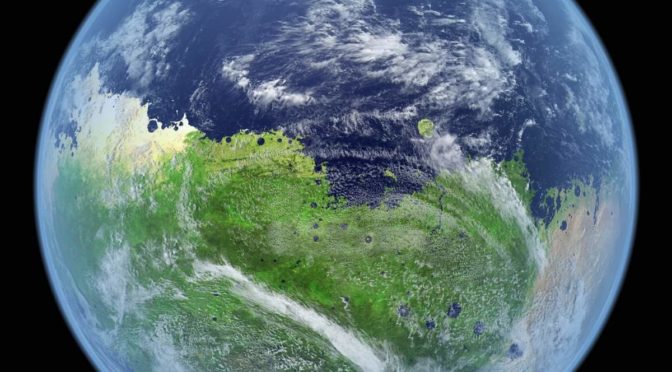What if Mars still had liquid water on its surface and a thick atmosphere filled with clouds, like Earth? How would it look like? Software engineer Kevin Gill of JPL (NASA’s Jet Propulsion Laboratory) wondered this and prepared an image using data from NASA’s Mars Reconnaissance Orbiter (MRO, see notes 1) and Mars Orbiter Laser Altimeter (MOLA, see notes 2). The result is stunning!
Gill picked an arbitrary sea level and used GIMP (a free and open-source raster graphics editor used for image retouching and editing) to paint the features onto the satellite images using these measurements.

Gill admits that his process was mostly artistic, rather than scientific. He says he and was inspired by NASA’s “Blue Marble” images.
It would be a great thing if we had another pale blue dot in our Solar System, though. Can’t we terraform Mars? Maybe, someday, in the far, far future. It will be hard, though.
In 2013, NASA also published a video that shows what did Mars look like when it had water (four billion years ago, there was liquid water on the Martian surface).
“Billions of years ago when the Red Planet was young, it appears to have had a thick atmosphere that was warm enough to support oceans of liquid water – a critical ingredient for life. The animation shows how the surface of Mars might have appeared during this ancient clement period, beginning with a flyover of a Martian lake.“
“The artist’s concept is based on evidence that Mars was once very different. Rapidly moving clouds suggest the passage of time, and the shift from a warm and wet to a cold and dry climate is shown as the animation progresses. The lakes dry up, while the atmosphere gradually transitions from Earthlike blue skies to the dusty pink and tan hues seen on Mars today.”
Where Mars’ Water Has Gone?
It is widely accepted that Mars had abundant water very early in its history, but all large areas of liquid water disappeared billions of years ago. Now the red planet is a cold desert world. But, where all this water has gone?
- Some of Mars’ water is probably lost to space, along with its atmosphere. But how much water did escape like that, it’s still unknown to us. According to a 2021 study, the red planet is still leaking water into space during dust storms and warmer seasons.
- Observations from orbit suggest that some of the Ancient water is on its poles, under the surface. The total volume of ice present in the polar ice caps (both north and south) is similar to that of the Greenland ice sheet.
- Some water may be trapped in hypothesized subglacial lakes.
- NASA’s Mars Reconnaissance Orbiter also detected vast Martian glaciers of water ice under protective blankets of rocky debris.
- According to a 2021 study, oceans’ worth of ancient Mars water may have been locked up in minerals in the red planet’s crust – 30 to 99% of its initial water. The study was published in the journal Science.

Notes
- Mars Reconnaissance Orbiter (MRO) is a multipurpose spacecraft designed to conduct reconnaissance and exploration of Mars from orbit. It was launched on August 12, 2005, and attained Martian orbit on March 10, 2006.
- The Mars Orbiter Laser Altimeter (MOLA) is an instrument on the Mars Global Surveyor (MGS) that mapped the height of surface features on Mars. It was one of five instruments on the Mars Global Surveyor (MGS) spacecraft, which operated in Mars orbit from September 1997 to November 2006. However, the MOLA instrument transmitted altimetry data only until June 2001.
Sources and Further Reading
- Mars Reconnaissance Orbiter on Wikipedia
- Mars Orbiter Laser Altimeter on Wikipedia
- “Where did Mars’s liquid water go? A new theory holds fresh clues.” on the National Geographic website
- Study: Long-term drying of Mars by sequestration of ocean-scale volumes of water in the crust. Science, April 2, 2021.
- “NASA Spacecraft Detects Buried Glaciers on Mars” on the NASA website
- “New Science Indicates Mars’ Water Didn’t Escape to Space – It’s Trapped in the Red Planet’s Crust” on the SciTechDaily website
- “Mars is leaking water into space during dust storms and warmer seasons” on Space.com
- “Mars water loss shaped by seasons and storms” on the European Space Agency website
- Moon Landings: All-Time List [1966-2025] - February 2, 2025
- What Is Max-Q and Why Is It Important During Rocket Launches? - January 16, 2025
- Top 10 Tallest Rockets Ever Launched [2025 Update] - January 16, 2025


